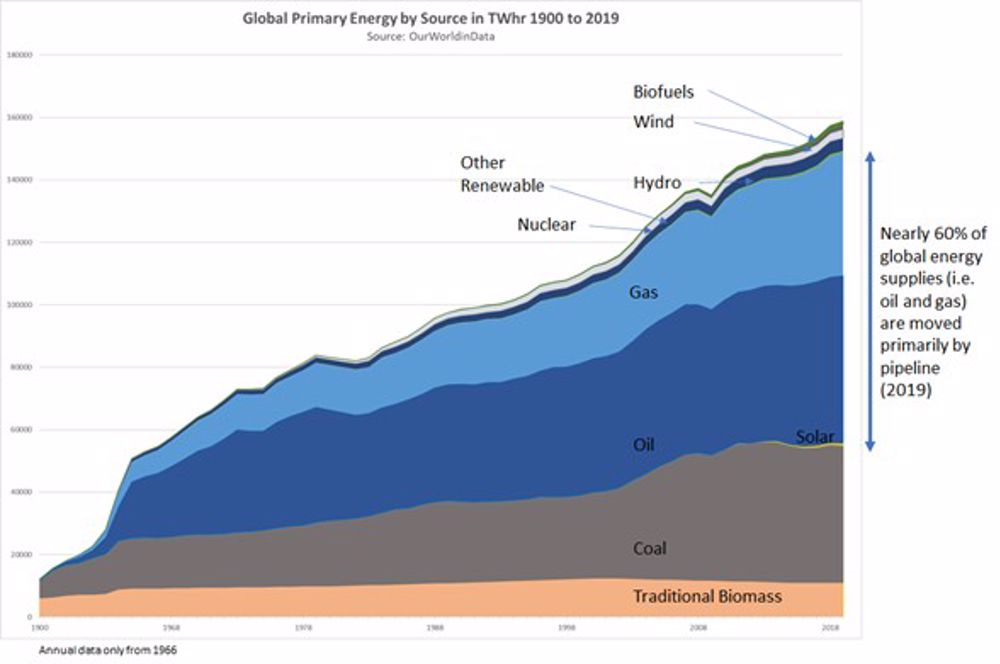Large Long Distance Pipelines
The safest and least cost way to transport large quantities of a liquid or gas is by pipeline. Today, nearly 60% of global primary energy supplies are mainly moved by large-scale long-distance pipelines.
In the early 20th century, the main means of moving goods on land was the railway and this included bulk quantities of crude oil and refined product. Moving by rail was flexible but not inexpensive and not without risks of incidents.
From the 1930’s onward and accelerated through the war years, large pipelines were built. Pipelines were laid in trenches to reduce the possibility of accidental damage and largely eliminate the visual impact on the environment.

In North America, many of these were for natural gas which was otherwise stranded. This allowed natural gas to replace gas manufactured from coal gasification. In the Middle East, the TAP line (Trans Arabian Pipeline) moved oil from the Arabian Gulf to the Mediterranean coast crossing several countries and was one of the earliest long-distance pipelines. The costs of laying and the quality of the pipeline was improved using sidebooms on caterpillar tracked bulldozers (Bechtel 1930 – photo in Building a Century, Bechtel). This meant the pipe could be fully welded and coated with corrosion protection conveniently above ground and the pipe string snaked into the trench – yes large bore high pressure steel pipe is flexible enough.
The construction of an onshore pipeline requires clearing a strip for the pipe trench and access track, once finished pipelines are largely invisible. Many types of agriculture can be allowed to take place over the pipe route. This is good for environmental visual impact but bad when later construction projects forget they are there. A properly constructed and maintained pipeline can last a hundred years or more. The cathodic protection system of an impressed electric current can balance out the corrosion due to small imperfections and damage. Periodic inspection by intelligent pigs run through the pipe can report on any corrosion that may be caused by contamination in the fluid being carried or failures of the cathodic protection.
Crude oil is delivered to refineries through networks of large diameter pipelines that allow inland refineries to be economic and stranded oil resources exploited. The next step in the technology will be the East African Oil Export pipeline being built for a consortium of companies to export a waxy crude from the Great Lakes region to the coast. To pump the crude oil, the pipeline needs to be kept hot for its entire length. At 1443 km, this will be the longest electrically heated pipeline in the world.
Today, a complex network of high-pressure pipelines (approx. 100 bar) interconnects gas producers and consumers in North America and separately Europe. This has allowed natural gas to become a low cost, highly competitive and efficient market in these two areas. The availability of natural gas in these markets has allowed the growth of Combined Cycle Gas Turbine generation of power, the least cost and least polluting fossil fuel powered option. Coal is not an option for new power stations in competitive markets such as the USA, where the average age of coal fired power stations is over forty years.
Chemical engineers design these long-distance pipelines, balancing the economics of line pipe size against the cost of compression and ensuring that the flow is at appropriate velocities (e.g., below sonic). The composition of gas in the pipeline is maintained at agreed specifications, to ensure that the customers’ burners remain stable, and no problematic materials are introduced into the line, such as water and heavier hydrocarbons that may condense out.
The development oil and gas resources has depended on developments in pipeline technology to be able to monetize the resources. Today, pipelines are laid in water up to 3000m deep by specialised vessels. To avoid processing well fluid offshore, which is very costly, pipeline technology has been developed to carry multi-phase flows (gas, hydrocarbon liquid and water) to shore. Sophisticated modelling is carried out by chemical engineers to ensure reliable flow of this mixture. Onshore pipelines with intermediate compressor stations carry gas across continents to markets.
The industry has now started to look how to decarbonise. This is being dealt with through sophisticated monitoring to detect fugitive emissions of methane, so that they can be dealt with. Some of this monitoring can now be carried out on a macro-scale by satellite observation. Fugitive emission surveys of areas where leaks can occur, such as pressure reducing stations and compressor stations, are becoming standard practice. Carbon emissions of compressor stations are starting to be reduced by using electric drives rather than direct driven from gas turbines. Even if the electricity is generated from CCGTs (Combined Cycle Gas Turbine), their efficiency means that carbon dioxide emissions are lowered. If the electricity is generated from renewable sources, then the situation is even better.
Pipelines are generally a safe method of transporting fluids. Pipelines are designed with block valves to allow sections to be shut down quickly once a leak is detected. Even major damage to natural gas pipelines usually results in the gas dissipating upwards due to its low density and only results in hazards if trapped. Oil pipeline fractures are usually quickly spotted, and clean-up of the leak area is usually effective, although biological clean-up of contaminated soils may take a year. LPGs are more hazardous materials to transport by pipeline and a failure in the main LPG export line from Siberia in 1989 is believed to have killed about 800 people when two trains crossed in the large gas cloud from the leak. LPGs being heavier than air had not dissipated and the pipeline operator believing that the drop in pressure was due to an underperforming pump, started additional pumps. Similar pipelines have valves at frequent intervals and sophisticated monitoring systems. Leak scenarios are modelled using Quantitative Risk Analysis to assess the risk and consequences of a failure.